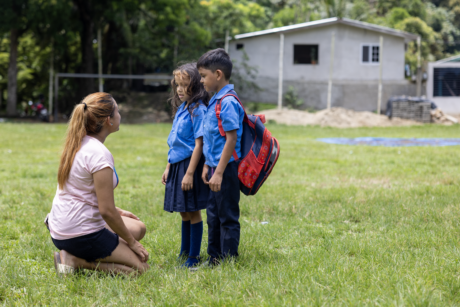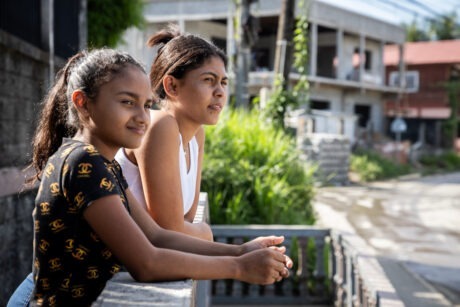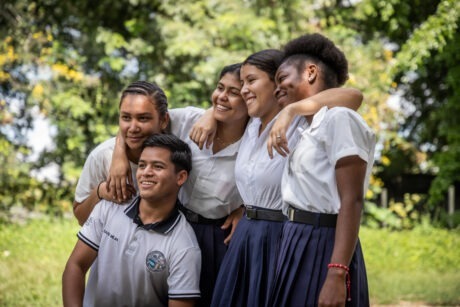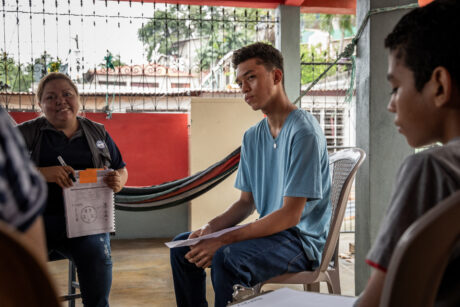San Pedro Sula, HondurasTesla Mellage marche régulièrement entre les lignes de sécurité jaunes qui la guident à travers le monde moderne, vaste usine de Plásticas Industriales Hondureños S.A., connu localement sous le nom de PLIHSA, qui est le plus grand fabricant du pays de contenants omniprésents utilisés pour transporter des boissons gazeuses, beer and other beverages.
She wears foam earplugs to sequester the loud noise radiating from the sophisticated injection mold machinery, though still listening intently as a colleague speaks loudly to explain the production process. They stop and reach into a four-foot-high container and pick up multicolored plastic pellets that will soon be transformed into another sturdy crate.
A week earlier in August, Mellage plunged her hands deep into another PLIHSA endeavor — the soft, warm dirt in a community park. Community leaders and residents in Nuevo San Juan — about an hour from PLIHSA’s factory in La Lima, Mellage — hand-planted a half-dozen small trees to kick off a corporate social responsibility project.
Like PLIHSA’s innovative production facility, which includes metal “crown” bottle caps, the company wanted its corporate social responsibility program to be different.
“It’s not about philanthropy or writing a check and then moving on,” says Mellage, Director of Corporate Affairs Strategy for PLIHSA’s parent company, Grupo Milenio. “It’s about collaborating to be a part of the solution.”
Établi en 1965, PLIHSA did not have a corporate social responsibility program until Grupo Milenio took over the company in 2021, says Vanesa Cuéllar, a PLIHSA employee who works on environmental protection and leads the plant’s volunteering efforts.
“We did not engage in these types of activities for the community,” says Cuéllar, who has been with PLIHSA for nine years. "Donc, when Grupo Milenio came in, they brought that confidence and the faith in how we can contribute to help the communities.”
Since most of PLIHSA’s employees live in Choloma and La Lima — areas with high rates of violence and irregular migration — the company decided to focus its corporate social responsibility efforts on those nearby municipalities.
Strategic partnership formed
PLIHSA’s desire to support communities coincided with conversations already underway with USAID’s Sembrando Esperanza, an innovative program working to improve human security, boost social cohesion, unite communities around common causes and curb irregular migration.
Sembrando Esperanza partners with local governments, civil society and the private sector to support locally driven solutions to community-prioritized challenges in 10 municipalités, including Choloma and La Lima.
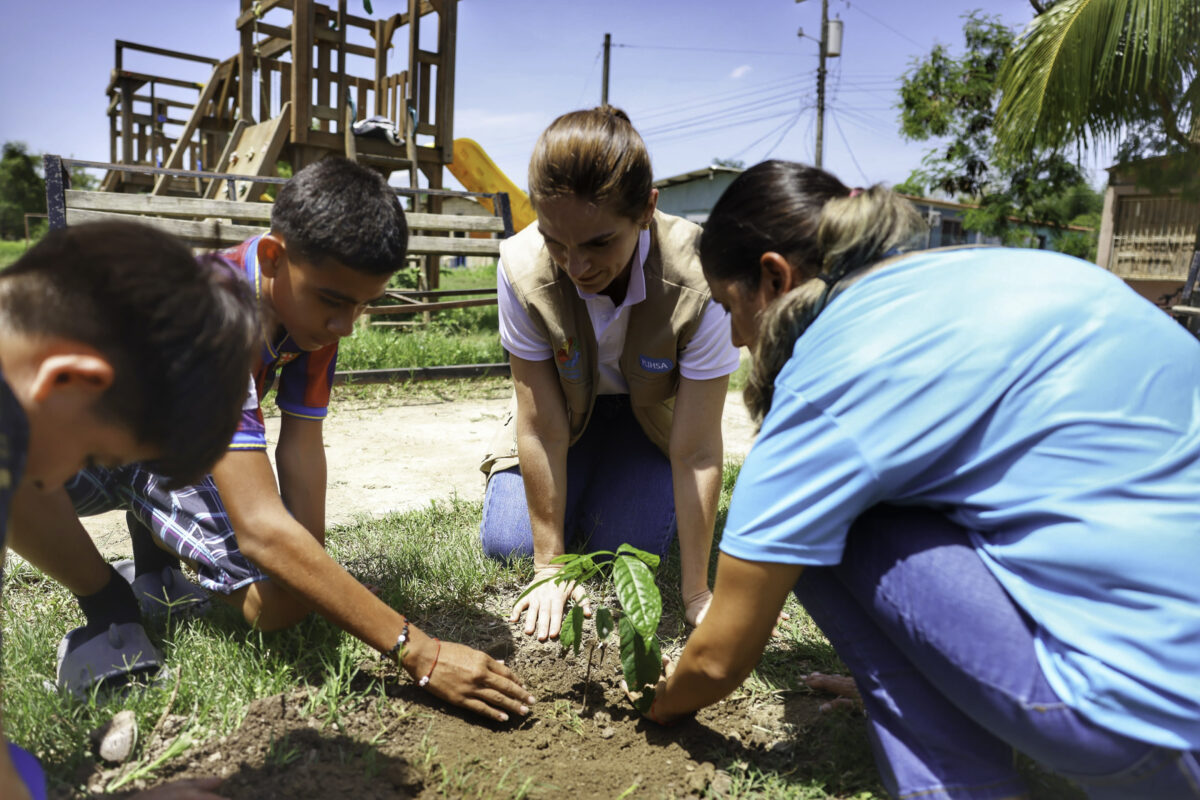
The project seeks private sector partners with a shared vision of “collective efficacy,” the belief within a community or group in its ability to effect change. Collective efficacy fosters a sense of community ownership and builds social cohesion and resilience — factors that combine to increase stability and develop a sense of rootedness.
The partnership was the right fit. Sembrando Esperanza’s technical expertise and systematic approach to co-creation allowed PLIHSA to work directly with communities, support local decision-making and target its financial support to specific opportunities.
The PLIHSA partnership was one of seven new alliances, including five companies that had never worked with a USAID-supported program, created by Sembrando Esperanza during the past 12 mois. These alliances, which generated more than $1.5 million of private sector support for target communities, are consistent with USAID’s private sector engagement strategy.
Good communities with big challenges
From the air, Nuevo San Juan is a picturesque peri-urban area. Located about a 20-minute drive from La Lima’s center, Nuevo San Juan’s residents live in communities called “bananeras” because they grew out of the old banana plantations.
They are concentrated in tightly formed neighborhoods, living primarily in modest concrete homes and semi-paved streets. The tight-knit community is bracketed by small farmers’ fields, rivers, roadways and a few still-operating banana plantations.
PLIHSA employee Eddie Joel Tabora was born and raised in the municipality. "El limeño,” as people from the area are called, “are well known as hard workers who enjoy sports,” says Tabora, who has been with PLIHSA for two years as an injection molds supervisor.
Malheureusement, these cities struggle with major challenges. PLIHSA’s Tabora says the municipality of La Lima receives too few investments and too little attention.
“People find themselves needing to emigrate from the country to seek new experiences and job opportunities,” says Tabora. “In the case of young people, they sometimes look for comfort by settling in places and with people who are not very good in this regard. They seek refuge in gangs or criminal groups because they cannot find work.”
Engaging at-risk youth
PLIHSA and Sembrando Esperanza collaborated with local leaders to target youth ages 12 à 29 who could identify and affect positive changes in their neighborhoods.
“We thought it would be good to empower the youth so that they could be the authors of their own future,” Mellage says. “We want them to feel like they are the writers of that story.”
The youth were recruited to become “Agentes de Cambio” (Agents of Change in English), a program designed to engage them in civic activities and promote safe, inclusive spaces at home and in the community. Implemented elsewhere in Honduras by Sembrando Esperanza, le Agentes de Cambio program has achieved measurable and sustainable changes in their respective communities.
Yehring Pineda, Regional Coordinator of USAID’s Sembrando Esperanza, dit le Agentes de Cambio program has made significant strides in boosting residents’ connection and attachment to their neighborhoods, known as “rootedness.”
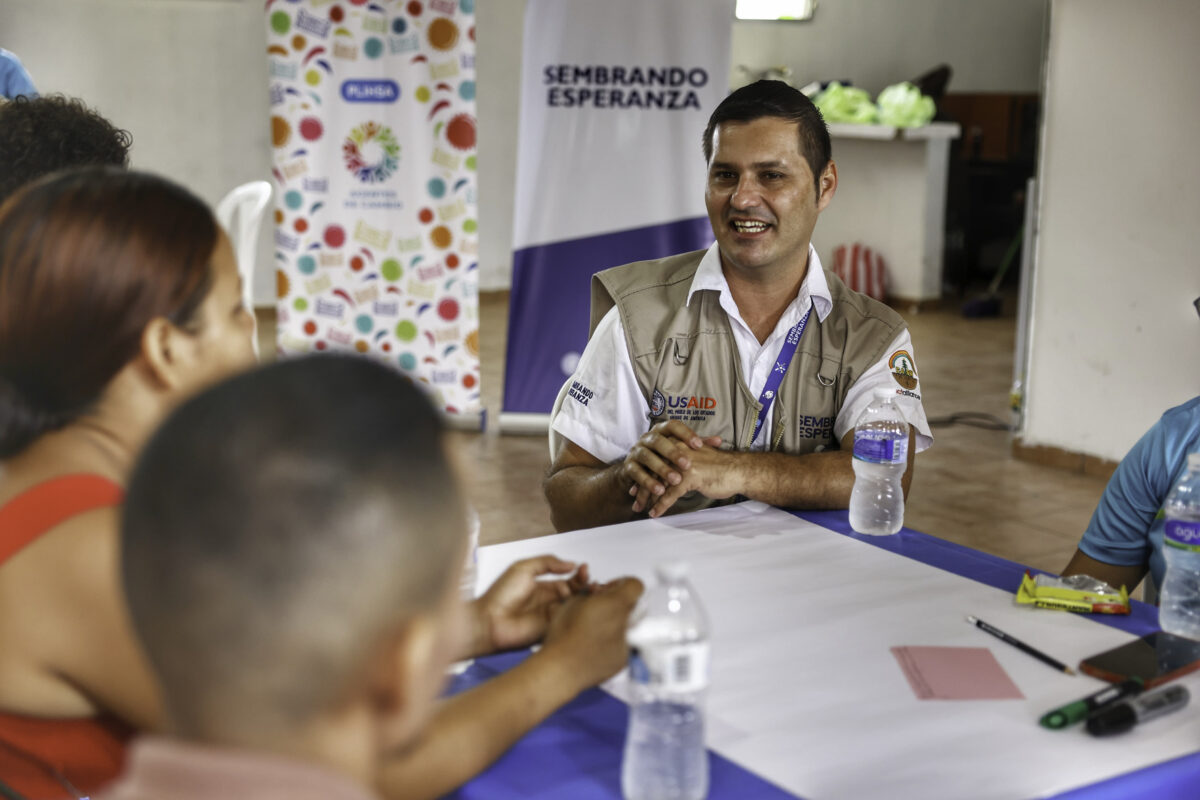
Tous Agentes de Cambio undergo a four-part training course on leadership, assertive communication, résolution de conflit, acting without causing harm and creating safe spaces.
“They develop leadership skills, but at the same time, they generate actions to ally with others in the community,” Pineda explained to La Lima’s municipal officials during an August 5 program overview. “This allows young people to gain knowledge and skills to identify problems in the community and, en même temps, propose solutions to what they consider is affecting them in their communities.”
Plus que 160 youth — of which nearly 100 women — in La Lima’s metropolitan area participated in the Agente de Cambio training sessions, Pineda reported.
As the training progressed, the youth slowly transformed from roles of being seen but not heard, says PLIHSA’s Cuéllar, leader of the company’s volunteer efforts.
"Au début, they were very quiet and didn’t express themselves much,” recalls Cuéllar. “Through these co-creation groups and various activities, they started opening up. They began to come out of their shells.”
Setting priorities for positive change
As each Agente de Cambio developed their individual skills, the youth learned to spot and prioritize the challenges that affect their communities, families and themselves. Dividing themselves into groups to address violence and irregular migration, they used these breakout sessions to brainstorm ideas.
“They began writing down what came to their minds regarding the problems they faced in their communities,” Cuéllar says. “After hearing all these brainstorming ideas from the young people, the project’s structuring phase began.”
Sembrando Esperanza’s Pineda said the outcomes from these brainstorming sessions and subsequent steps were tangible and remarkable.
“They were also able to identify the roles or power actions present in the community,” Sembrando Esperanza’s Pineda said. “This analysis allowed them to develop skills to identify and prioritize problems to propose possible solutions for the projects or project profiles they created. It also helped them identify the capacities or resources available in the community or the resources that the youth have in the community to address these issues.”
Pinpointing problems and suggesting solutions
While PLIHSA and Sembrando Esperanza were aware of the challenges facing communities like Nuevo San Juan, le Agentes de Cambio described the problems in greater detail and offered home-grown solutions.
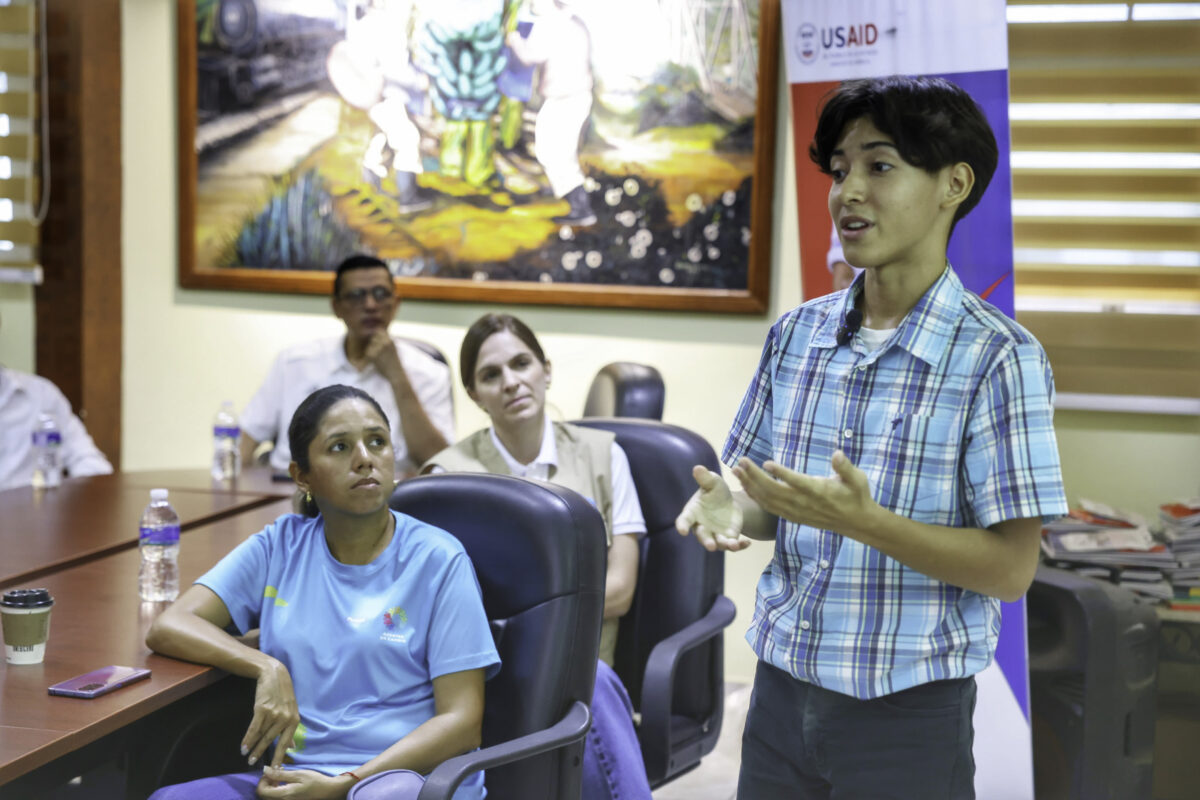
Eighteen-year-old Agente de Cambio Carlos Rodríguez Tovar lives near La Lima and is all too familiar with these problems.
“Our main vulnerability is flooding," dit-il. “Floods affect us during rains and hurricanes that impact our country and come directly to our municipality, affecting our community of Nuevo San Juan.”
Distinct high-water marks extend up to three feet on the walls of many concrete homes, constant reminders that their humble homes are not impervious to Mother Nature. Experts say the excessive flooding is caused by intense tropical storms, urbanization and a lack of public infrastructure.
"Fréquemment, a father and a young person go to the United States or migrate to another country,” Rodríguez Tovar says. “It affects a lot of young people. Alors, when these natural phenomena occur, it creates even more chaos. Because of our vulnerability, everything falls apart. It’s chaos.”
To reduce flooding, Rodríguez Tovar and his team devised a plan called “Pongámonos Pilas” (“Let’s Get Motivated” in English) to motivate young people to revitalize public spaces. The plan included an aggressive effort to clean green spaces, prevent trash from clogging drainage canals and plant trees.
Throughout the process, Rodríguez Tovar says PLIHSA was involved in each step.
“They have not only been observing but also actively participating, talking with us and being integrated in our conversations,” the 18-year-old says. “As young people, we can see this solution and the benefits it brings us, and we can clearly take action in our community.”
In addition to PLIHSA, La Lima’s mayor and city council voted to support the mitigation plans developed by Rodríguez Tovar and other Agentes de Cambio.
Improving the community, changing lives
Several months into the “Pongámonos Pilas” plan, the community in general and the youth in particular are seeing results — two goals established by PLIHSA and USAID’s Sembrando Esperanza.
Beyond the project implementation, PLIHSA’s Cuéllar says you can see the difference among the Agentes de Cambio.
“You can really see their enthusiasm. They feel heard," dit-elle. “They have developed in an impressive way. They seem like true professionals. We are amazed by the potential each of these young people has.”
Eighteen-year-old Rodríguez Tovar feels like a different person.
“I used to be very nervous, but seeing the results now and looking at myself effectively in front of others, they tell me that I have had a great change," dit-il. “I see this result as a benefit and a significant step I have taken, and clearly, it is about supporting vulnerable communities. That is my vision, to be able to support and provide solutions to people and to guide them as a future professional and advisor. I want to help them technically.”
For PLIHSA’s employees, this form of corporate social responsibility strikes a positive note with them.
“I felt very happy and excited because I didn’t imagine that the company would choose to support the municipality of La Lima,” says Tabora, the injection mold supervisor. “We feel more committed to PLIHSA because the initiative is aimed at helping young people, especially in the villages, communities and neighborhoods of La Lima.”
With reporting by Luis Villatoro in San Pedro Sula and La Lima.
